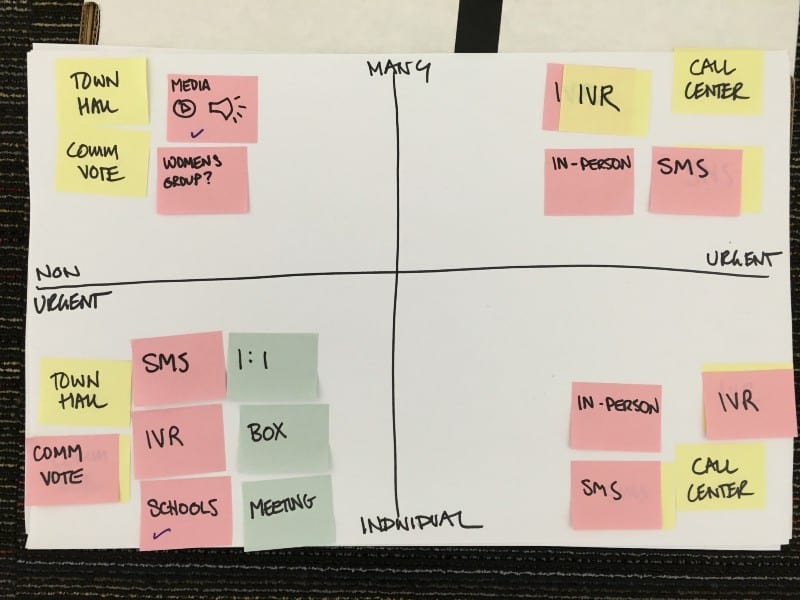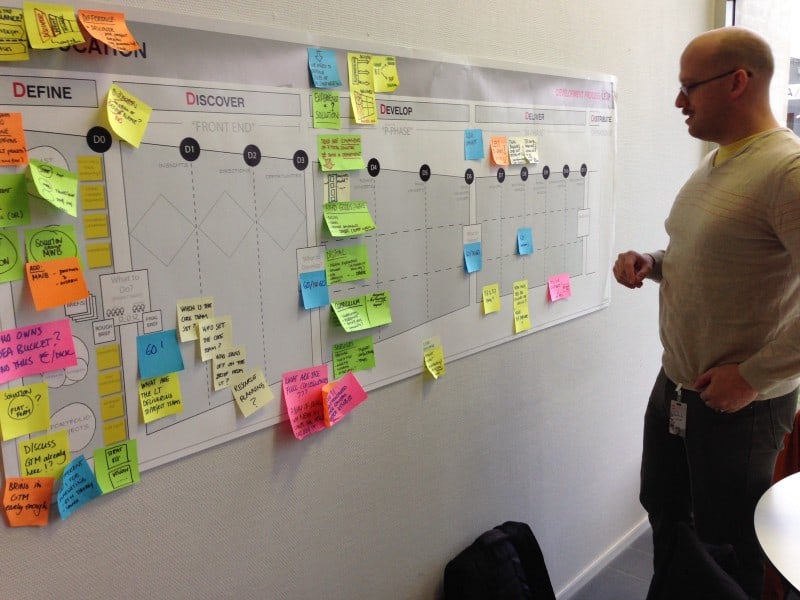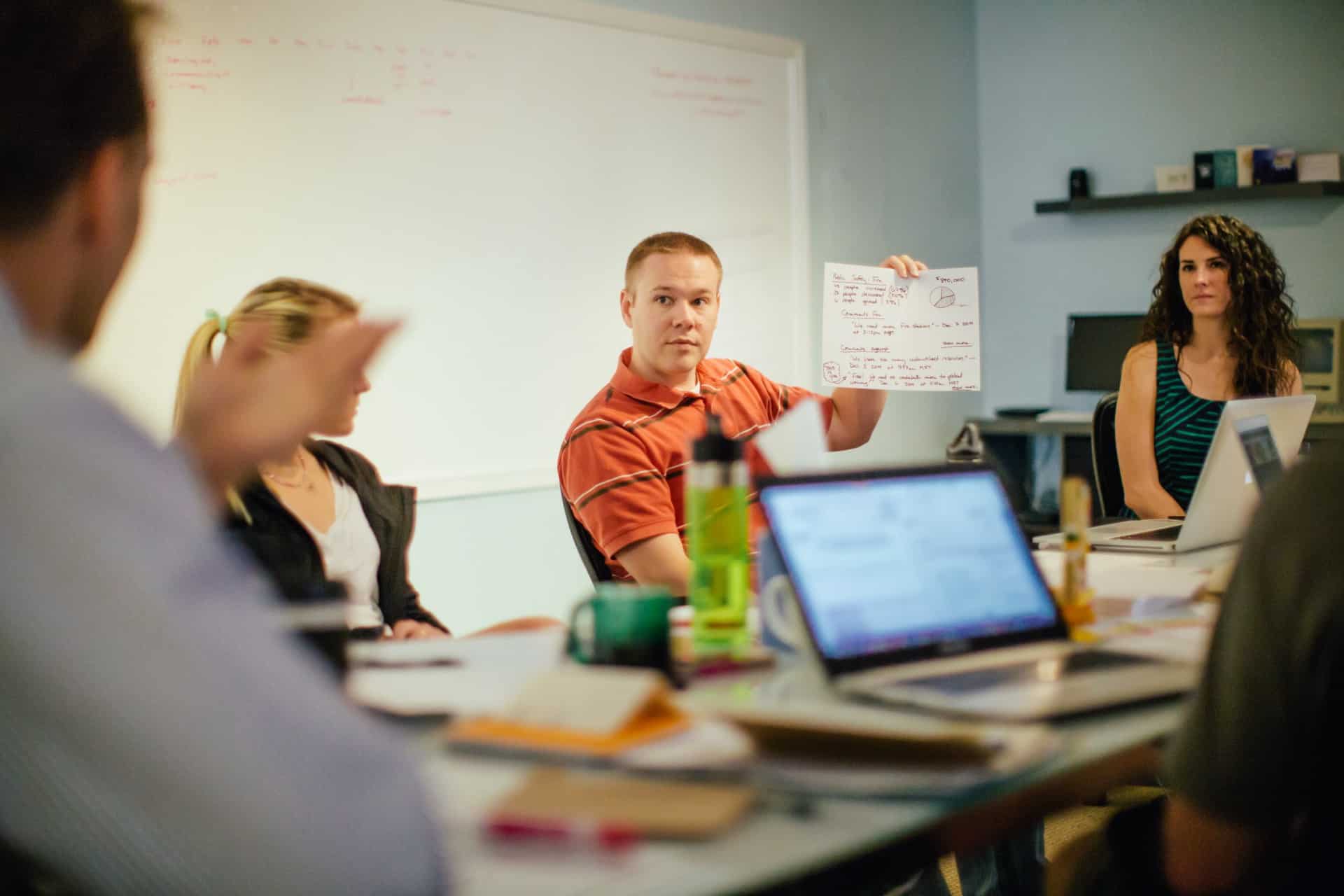Welcome to Week 4! We’re so close and have come a long way, but we’re not done just yet. In fact, this week may be the most important because it synthesizes (i.e. boils everything down) into a decision-enabling Roadmap. All the research, prototypes, insights and learnings now lead to a single focus. This is
OK, so let’s recap for a second. Last week in the Workshop you were focused on prototyping, and hopefully that was a beneficial learning experience. You’ve talked to a lot of people and put them first, you’ve failed and kept going on your prototypes, and hopefully all of that hard work has come together to feel like you have a plan moving forward. Wait… what do I need to have the right plan? This week is for answering that question.
Synthesis
Basically, this is a fancy way of saying that you need to take a wide world of research, learnings, hunches and ideas that you’ve gathered in the previous weeks and start to make it all into a collective thing. Imagine you’re baking a cake. Each of the individual ingredients is crucial. On their own, they’re just eggs and flour and sugar and oil, but together, in the right proportions, in the right way, it makes something delicious. That last step of merging all the ingredients together and putting it in the oven… that’s synthesis.
To run a synthesis session with your team is logistically not that hard. It’s the concepts and execution that you’ll cover in that time that can be challenging. We know through experience that it’s not easy to take weeks worth of learnings and make it matter, so let’s do it together step by step.
Simplify and Focus
In a perfect world full of unicorns, the Workshop and prototyping were crystal clear and you left with a simple, focused plan. Easy, right? If that happened, you can skip ahead a bit (on your flying carpet because you’re impressive like that ?). For the rest of us in the real world, this might not have worked out exactly that way. And that’s okay. Totally, completely, you’re-normal, okay. But, it does mean you have a little bit of work to do to get to a focused Roadmap. So let’s get to it. To get there, here are the things to do:

- Group Your Concepts—One of the most basic things you can do is to group the ideas you’ve developed that are still standing strong. Hopefully you still have even some of your earliest notes; combine those with your more recent findings (and anything in between) and look at them all together. A simple way to do this is to make a 2×2 grid with four quadrants, with the X and Y axis of the grid representing two themes you are especially interested in. If an idea is strongly only one of these themes, put it in the far corner of that quadrant. If it’s in the middle of both, place the idea squarely in the middle of the grid. At the end of the exercise you’ll get a helpful map of your ideas.
- Focus on Guiding Principles—Based on your 2×2, start to create a handful of statements that state the insight or learning in a simple way that you can carry forward. Maybe you’re seeing a theme of ideas falling into a focused narrative. Make a short statement that carries the idea of these forward. Basically, take a handful of very similar, important ideas and write them into one all-encompassing sentence. Do the same thing with the other leading themes, and carry these forward into your Roadmap.
- Make Some Tough Decisions—Now is the time to think about the ideas that won’t make it past this point. We’ll talk about this again later on a bigger scale, but open up your thinking to start making some tough decisions. Use the principles you’ve developed and focus on who you’re building for, what they need most, and what you can build within the realities you’re up against. Maybe you have a great idea but not enough funding… that could be an idea for a later day. Or, like before, park these ideas and come back to them later, but don’t include them as a part of your near-term Roadmap.Define SuccessIt’s time to start thinking about what you want to achieve as a team and how this Roadmap can get you there. Do you want to affect 10 people or 10,000? There are no wrong answers here, but defining what you want to do and understanding what success for your team looks like will help you make some decisions in the Roadmap. Be bold, be realistic, and think about success in increments to get there.

Roadmap
Alright folks. This. Is. It. Home stretch. Weeks worth of work, planning, grinding, learning, growing, failing, iterating, prototyping and improving has brought you to here.
So why is a Roadmap so important? All of the work you’ve done together deserves a plan and a path to get there. Innovation comes when good ideas are put into action. These ideas are hard work, they’re valuable, and they deserve a life outside of this. And, frankly, we’ve learned the hard way on projects over the years that when we didn’t have clear Roadmaps, they don’t have their best shot at big impact. They’re harder, more expensive, longer and tougher to implement. Everything is easier with a plan. So let’s talk about how to build on your synthesis and make one.
Framework
The building blocks of a great Roadmap start with some pretty basic components. Primarily what you’re interested in doing with this is to catalog the work you’ve done so far, get specific about where you’re headed (and how to get there), and use it all to keep building towards Pilot.
A good template to follow in creating this should follow a setup like this one:
A. What You’re Building
Product Definition & PositioningWhat is it For, Whom is it For
B. How It’ll Work
User JourneyKey Features
C. Next Steps
Timeline and Milestones
D. Getting to Pilot
What it Needs to Succeed (Spoiler: more on that next week)
Now, instead of going over each of these steps individually, let’s talk about the most important steps along the way. These are the biggies.
Product Definition and Positioning
It’s important to get specific now about what you are building and really spell it out. For example, say all of your work has your team thinking you need a mobile application for at-risk youth. Okay, that’s the big vision. Now, define the details. Is it iOS or Android? Both? Is it mobile or tablet? Are there existing apps that are similar? What would it cost to build something like this? How many users would mark success for your team? These questions and others like it are crucial at this point in the process. Dig into the details, and document the outcomes.
As we stay focused on people, it’s important to think about who is going to use this product or innovation, and where it is positioned in their lives. As always, stay human-centered, and focus on the people in the process.
User Journey
One of the primary benefits of a Roadmap is the ability (and need) to bring others into the mix, and that means you need to convey to others the story of what you’re building. In our experience, maybe the easiest way to do this is by building a user journey. We’ve done everything from simply writing these in a very to-the-point narrative, all the way to hiring illustrators or a video team to literally draw out or visualize the story. And don’t underestimate the value these important post-project artifacts this work will create. Telling the story in a compelling way is crucial, so tell the story in a people-first, people-focused way.

Timeline and Milestones
This is the most important part of a Roadmap. It is vital to chart the course as you move forward, and that is going to include getting specific about dates, times and milestones. It’s time to get into the weeds, have some heart-to-hearts with your team, and really make sure you have the details worked out. A few tips: don’t overdo it, plan buffers into the schedule, and think about the timeline in short increments that combine to a full-spectrum plan.
Gut Check & Next Steps
Now that you’ve gone through the process of thinking about next steps and charting the Roadmap, let’s take a purposeful pause. This is important. Let’s get real for a minute.
Here’s the big question now: Does what you’ve laid out feel like the right step moving forward?
We’ve learned that when we get to this important question in our process, we typically land on one of three directions:
Carry it forward internally. If you believe that you have the capacity to see this effort through past the Roadmap, then just keep going! If this is the case, explain how you see that working with your team, and consider this a great time to bring new people in or excuse teammates who are getting pulled in new directions.Build capacity before moving forward. It’s possible that this exercise has shown the problem is too big to tackle right now, so focus on giving attention to other priorities and build the capacity that it needs before trying to go any further. While this option might not feel the best right now, trust us when we say this is often exactly the right move to make. Knowing when to move is often far more important than what or howto move forward.Partner with others to execute as you guide.
Maybe you believe that another partner would be perfect for getting the next steps created. Of course, this is the most involved option, but also the option that gives the idea the proper room it might deserve.
No matter what you decide, step into the direction with confidence, knowing that you’ve done what is best for your team and the situation at hand. Each problem is so unique. Follow your gut.
Wrap Up
So that’s it for now! In our next (and final) installment we’ll officially tie a bow on things. We’ll talk about how to close out our four-week process, how to start thinking about funding and tracking towards a Pilot, and how to focus on building a culture of innovation. It’s officially safe to say that the hardest work in the process is behind you, so pat your team on the back and go prop your feet up somewhere, then check back with us soon for one more time with us.

